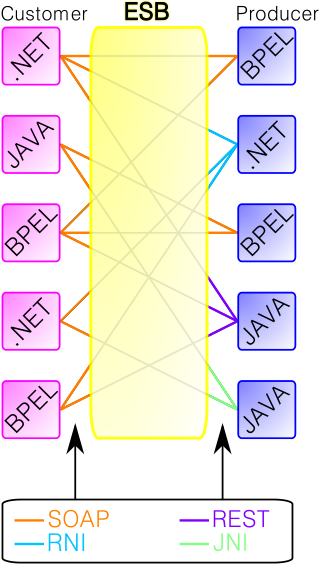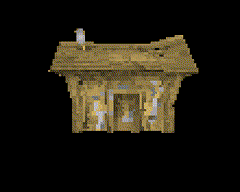
Microsoft DirectX is a collection of application programming interfaces (APIs) for handling tasks related to multimedia, especially game programming and video, on Microsoft platforms. Originally, the names of these APIs all began with "Direct", such as Direct3D, DirectDraw, DirectMusic, DirectPlay, DirectSound, and so forth. The name DirectX was coined as a shorthand term for all of these APIs and soon became the name of the collection. When Microsoft later set out to develop a gaming console, the X was used as the basis of the name Xbox to indicate that the console was based on DirectX technology. The X initial has been carried forward in the naming of APIs designed for the Xbox such as XInput and the Cross-platform Audio Creation Tool (XACT), while the DirectX pattern has been continued for Windows APIs such as Direct2D and DirectWrite.
Direct3D is a graphics application programming interface (API) for Microsoft Windows. Part of DirectX, Direct3D is used to render three-dimensional graphics in applications where performance is important, such as games. Direct3D uses hardware acceleration if it is available on the graphics card, allowing for hardware acceleration of the entire 3D rendering pipeline or even only partial acceleration. Direct3D exposes the advanced graphics capabilities of 3D graphics hardware, including Z-buffering, W-buffering, stencil buffering, spatial anti-aliasing, alpha blending, color blending, mipmapping, texture blending, clipping, culling, atmospheric effects, perspective-correct texture mapping, programmable HLSL shaders and effects. Integration with other DirectX technologies enables Direct3D to deliver such features as video mapping, hardware 3D rendering in 2D overlay planes, and even sprites, providing the use of 2D and 3D graphics in interactive media ties.

VRML is a standard file format for representing 3-dimensional (3D) interactive vector graphics, designed particularly with the World Wide Web in mind. It has been superseded by X3D.
A game engine is a software framework primarily designed for the development of video games and generally includes relevant libraries and support programs such as a level editor. The "engine" terminology is akin to the term "software engine" used more widely in the software industry.
Fahrenheit was an effort to create a unified high-level API for 3D computer graphics to unify Direct3D and OpenGL. It was designed primarily by Microsoft and SGI and also included work from an HP-MS joint effort.
Magnetic Scrolls was a British video game developer active between 1984 and 1990. A pioneer of audiovisually elaborate text adventure games, it was one of the largest and most acclaimed interactive fiction developers of the 1980s, and one of the "Big Two" with Infocom according to some.
RenderWare is a video game engine developed by British game developer Criterion Software.
Game programming, a subset of game development, is the software development of video games. Game programming requires substantial skill in software engineering and computer programming in a given language, as well as specialization in one or more of the following areas: simulation, computer graphics, artificial intelligence, physics, audio programming, and input. For multiplayer games, knowledge of network programming is required. In some genres, e.g. fighting games, advanced network programming is often demanded, as the netcode and its properties are considered by players and critics to be some of the most important metrics of the game's quality. For massively multiplayer online games (MMOGs), even further knowledge of database programming and advanced networking programming are required. Though often engaged in by professional game programmers, there is a thriving scene of independent developers who lack a relationship with a publishing company.
Direct3D and OpenGL are both application programming interfaces (APIs) that can be used in applications to render 2D and 3D computer graphics. As of 2005, graphics processing units (GPUs) almost always implement one version of both of these APIs. Examples include: DirectX 9 and OpenGL 2 circa 2004; DirectX 10 and OpenGL 3 circa 2008; and most recently, DirectX 11 and OpenGL 4 circa 2011. GPUs that support more recent versions of the standards are backwards compatible with applications that use the older standards; for example, one can run older DirectX 9 games on a more recent DirectX 11-certified GPU.
In computing, D3DX is a high level API library which is written to supplement Microsoft's Direct3D graphics API. The D3DX library was introduced in Direct3D 7, and subsequently was improved in Direct3D 9. It provides classes for common calculations on vectors, matrices and colors, calculating look-at and projection matrices, spline interpolations, and several more complicated tasks, such as compiling or assembling shaders used for 3D graphic programming, compressed skeletal animation storage and matrix stacks. There are several functions that provide complex operations over 3D meshes like tangent-space computation, mesh simplification, precomputed radiance transfer, optimizing for vertex cache friendliness and strip reordering, and generators for 3D text meshes. 2D features include classes for drawing screen-space lines, text and sprite based particle systems. Spatial functions include various intersection routines, conversion from/to barycentric coordinates and bounding box and sphere generators.

An enterprise service bus (ESB) implements a communication system between mutually interacting software applications in a service-oriented architecture (SOA). It represents a software architecture for distributed computing, and is a special variant of the more general client-server model, wherein any application may behave as server or client. ESB promotes agility and flexibility with regard to high-level protocol communication between applications. Its primary use is in enterprise application integration (EAI) of heterogeneous and complex service landscapes.
Reality Lab was a 3D computer graphics API created by RenderMorphics to provide a standardized interface for writing games. It was one of the main contenders in the realtime 3D middleware marketplace at the time, alongside Criterion Software's RenderWare and Argonaut Software's BRender.

Software rendering is the process of generating an image from a model by means of computer software. In the context of computer graphics rendering, software rendering refers to a rendering process that is not dependent upon graphics hardware ASICs, such as a graphics card. The rendering takes place entirely in the CPU. Rendering everything with the (general-purpose) CPU has the main advantage that it is not restricted to the (limited) capabilities of graphics hardware, but the disadvantage is that more transistors are needed to obtain the same speed.

Rendition, Inc., was a maker of 3D computer graphics chipsets in the mid to late 1990s. They were known for products such as the Vérité 1000 and Vérité 2x00 and for being one of the first 3D chipset makers to directly work with Quake developer John Carmack to make a hardware-accelerated version of the game (vQuake). Rendition's major competitor at the time was 3Dfx. Their proprietary rendering APIs were Speedy3D and RRedline.
Desktop Window Manager is the compositing window manager in Microsoft Windows since Windows Vista that enables the use of hardware acceleration to render the graphical user interface of Windows.
Adreno is a series of graphics processing unit (GPU) semiconductor intellectual property cores developed by Qualcomm and used in many of their SoCs.
Umbra is a graphics software technology company founded 2007 in Helsinki, Finland. Umbra specializes in occlusion culling, visibility solution technology and provides middleware for video games running on Windows, Linux, iOS, PlayStation 4, Xbox One, PlayStation 3, Xbox 360, Wii U, handheld consoles, and other platforms. In 2021, Amazon acquired Umbra.
Q is a 3D engine / tech development platform / interoperability standard developed by the London-based developer Qube Software.

WebGL is a JavaScript API for rendering interactive 2D and 3D graphics within any compatible web browser without the use of plug-ins. WebGL is fully integrated with other web standards, allowing GPU-accelerated usage of physics, image processing, and effects in the HTML canvas. WebGL elements can be mixed with other HTML elements and composited with other parts of the page or page background.

GPUOpen is a middleware software suite originally developed by AMD's Radeon Technologies Group that offers advanced visual effects for computer games. It was released in 2016. GPUOpen serves as an alternative to, and a direct competitor of Nvidia GameWorks. GPUOpen is similar to GameWorks in that it encompasses several different graphics technologies as its main components that were previously independent and separate from one another. However, GPUOpen is partially open source software, unlike GameWorks which is proprietary and closed.






